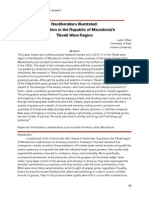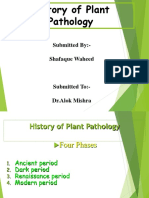Commercial Cultivation of Aloe
Commercial Cultivation of Aloe
Uploaded by
pana0048Copyright:
Available Formats
Commercial Cultivation of Aloe
Commercial Cultivation of Aloe
Uploaded by
pana0048Original Description:
Copyright
Available Formats
Share this document
Did you find this document useful?
Is this content inappropriate?
Copyright:
Available Formats
Commercial Cultivation of Aloe
Commercial Cultivation of Aloe
Uploaded by
pana0048Copyright:
Available Formats
Natural Product Radiance Vol 3(2) March-April 2004
85
Green page
Commercial cultivation of Aloe
Nilanjana Das* and R N Chattopadhay
Indian Institute of Technology
Kharagpur- 721302, West Bengal
*Correspondent author, E-mail: nilanjana00@lycos.com
Keywords: Cultivation, medicinal uses, Aloe vera, harvesting, yield,
economics.
IPC code; Int.cl.
7
A01G7/00, A61K35/78
The plant Aloe is as old as
human civilization and its versatile
properties for various purposes have been
well documented. The genus is found in
tropical and South Africa, Malagasy and
Arabia and introduced in other places for
ornamental and medicinal purposes.
Several species of the genus have been in
use under the common name of Aloe,
viz. Aloe vera Linn., A. barbadensis
Miller, A. ferox Miller, A. chinensis
Baker, A. indica Royle, A. perryi
Baker, etc., belonging to family
Liliaceae. Among these, A. vera Linn.
syn. A. barbadensis Miller is accepted
unanimously as the correct botanical
source of Aloe. In most reference books,
A. barbadensis Miller is regarded as the
correct name but as per the WHO
monograph, A. vera Linn. is accepted
as the legitimate name for this species.
A. vera is a succulent, almost
sessile perennial plant with multiple
tuberous roots and many fibrous
supporting roots penetrating into the soil.
The plants generally grow up to one meter
close to ground in typical rosette shape.
The leaves are radically arranged in two
or three circles. Each leaf is 30 - 50 cm
long and 10 cm broad at the base having
an indented margin. The leaves are pea
green in colour, occurrence of white spots
when young. Bright yellow tubular flowers
appear in a spike.
Aloes have long been in use for
several diseases, particularly connected
with the digestive system; they have also
been used for wounds, burns and skin
problems. The term Aloe stands for the
dried juice, which flows from transversely
cut bases of its leaves. It is the best herbal
answer to support the health and healing
mechanisms of the body because it does
not heal, rather it feeds the bodies own
systems in order for them to function
optimally and be healthy.
Pharmacologically it is an
immunity booster and detoxifies the
system. It is recommended in adjuvant
therapy with antibiotics, NSAIDs (Non
Steroidal Anti-Inflammatory Drugs) and
chemotherapy to eliminate drug induced
gastritis and other adverse effects. Useful
in various diseases such as type II diabetes,
arthritis, eye disease, tumor, spleen
enlargement, liver complaints, vomiting,
bronchitis, asthma, jaundice and ulcers.
Relieves constipation, maintains a good
gastric pH, helps in inflammatory bowel
disease, non- ulcer dyspepsia, gastric and
duodenal ulcers. A dietary supplement in
pre- and post-operative patients, post-
menopausal women and in cases of
osteoporosis.
A large number of research
workers have published their research
reports on cosmetic uses of A. vera and
at present it is in a great demand in the
market. The gel possesses good
moisturising properties and anti-wrinkle
properties. There are personal care and
skin care creams, moisture lotions,
shampoos and conditioners prepared from
Aloe gel. Additionally, there are
toothpastes, after-shave balm and sun-
screen lotion, hair styling gel that contain
Aloe in it to refresh and protect the skin.
There are a variety of every day,
household and other uses of A. vera.
Many people have found that by adding a
spoonful of Aloe gel mixed with 4-5 drops
of lemon juice provide a nice after bath
lotion. For burns, small amount of gel is
applied to the wound areas, which greatly
diminishes the chance of scaring and aid
in the healing as well as easing the pain.
By applying Aloe gel several times a day,
the redness of sunburn disappear within
Aloe sp.
Natural Product Radiance Vol 3(2) March-April 2004 86
Green page
a day or two without the skin peeling off.
Additionally, the creams containing Aloe
gel have been found to be effective in
treating frostbite injury and even psoriasis
in patients. Aloes are salt resistant species
and useful for seaside landscaping. Leaf
and flower stalk are pickled. Leaves yield
fibres and dye. The pulp is also valued as
a cooling application on inflammatory
joints. To relieve headache, a small piece
of sliced leaf is tied to the forehead. Some
Americans use the cold infusion in brandy
or liquor to relieve hemorrhoids.
Cultivation
A. vera is found as wild herb
along the coast of South India. It is under
cultivation in fairly large areas in many
parts of India, viz. Chhatisgarh,
Maharashtra, Madhya Pradesh, Gujarat,
etc. and also grown as ornamental plant.
It is a sure cash spinner and
progressive farmers can go for plantation
of it. Cultivation of this herb in a large scale
can make India move towards the
leadership in global herbal market and
this will fetch India good foreign reserves
as well as domestic economic prosperity.
Commercial cultivation of Aloe
has been started in many parts of India.
They can be grown in deserts and other
dry situations. They flourish in a variety of
climates and even on the poorest of soils,
but need protection from frost. No major
diseases or pest have been reported so far.
Soil: Naturally occurs in driest and
poorest soils and can be grown in variety
of soils. But the most ideal soil for it is
sandy loam that is slightly alkaline with a
pH up to 8.5. The root system of this plant
is shallow and does not penetrate deep
into the soil. However, water logged soil
is totally unsuitable.
Propagation: Aloe is normally
propagated through root suckers (pups)
or sometimes by cuttings of the new
growth. About 15-18 cm long root-suckers
or rhizome cuttings are planted by keeping
two third portion under the ground. Nearly
15,000 pups are required for plantation
of one hectare of land. Both plant-to-plant
and row-to-row, 60 cm 60 cm spacing
is to be maintained.
Irrigation: Aloe does not require much
water, however, soon after planting, the
land should be irrigated. It requires about
150 ml of water monthly for yield of good
quality leaf weighing approximately 1 kg.
The plant is irrigated through rain-fed and
sprinkler method.
Manure and Fertilizer: In India, Aloe
is raised as organic crop and only Farm
Yard Manure (FYM) is applied (12 15
tonnes/ha). In standing crop, cow-dung
is applied (5 10 tonnes /ha). Apart from
FYM and natural manures with good
nutritional value at the time of land
preparation, it demands additional annual
supplements like ammonium nitrate for
optimum yield.
Harvesting/Yield
Leaving the fresh and young
leaves from the top, older outer leaves are
generally harvested. The plants can be
removed manually or with the help of a
tractor-drawn disc harrow or cultivator.
New leaves grow from the center upward.
Offshoots are grown spontaneously next
to the mother plant. Crop is ready to
harvest after 18 months of sowing.
Economic yields are obtained in
5 years after that it needs replanting. In
India, the average yield for organically
grown Aloe is about 12 tonnes/ha (on
fresh weight basis).
Post-harvest care/Processing
Immediately after harvesting, the
Aloe leaves are tipped, tailed, and its spiny
ridges are removed after harvesting. For
the extraction, juice is allowed to drain
from the cut leaves into suitable vessels
or it can simply be squeezed or grinded
to get the gel. There are other
sophisticated ways to separate the gel
without loss of the product quality. The
juice is concentrated by evaporation,
either spontaneously or more frequently
by boiling.
The properties of Aloe are in the
concentration of all the elements that it
contains and no particular extract or part
of its components stands out individually
in the health benefits of A. vera. For this
reason, Aloe gel is just the juice of the
plant, cold processed with a minimum of
authorized additives for its stabilization.
In pharmaceutical laboratories, strict
quality controls are carried out at each
stage of processing in order to guarantee
the condition of materials used and the
final product.
Market scenario
The current global turnover of
raw Aloe leaves amount up to US $ 70
80 million dollars, which is expected to
grow at a rate of 35 % in the next five years.
For processed derivatives and value added
products, current global trade is estimated
at around US $ 1 billion and US $ 25
billions, respectively.
Natural Product Radiance Vol 3(2) March-April 2004 87
Green page
USA supplies the major bulk of Aloe
in world market having a share of 60
65 %, whereas Latin American countries
20 25 % and Australia, China and India
has a market share of only 10 per cent. It
is estimated that about 40-50 thousands
rupees could be earned annually by a plant
grower from Aloe cultivation.
Indoor cultivation of Aloe
Generally, Aloe grows openly in
the field, but it can also be grown indoors
in pots kept in sunny southern or eastern
window. Containers have to be filled a
quarter full with drainage material and
compost consisting of two parts loam and
one part coarse sand, broken bricks and
crushed limestone, with a bit of bone meal
added. Plant should be potted in the spring
and watered carefully until established.
During the summer, water can be given
as soon as the soil is dry, but from
September to March very little water is
needed, just enough to prevent the leaves
from shriveling. Over watering will kill the
plant. Well-rooted plant will benefit from
occasional applications of dilute liquid
fertilizer in the summer. Large plants,
however, do need an occasional top
dressing of fresh soil in each spring; any
loose soil should be removed and replaced
with new. The drainage holes should be
plugged up. Once established, the mother
plant will send off shoots, which may be
transplanted when they are at least 2.5 to
5 cm tall. In fact, Aloes do not need to be
repotted often; plants in large pots will
flourish for many years without being
moved. The plant takes four years to reach
the maturity and has a life span of about
12 years. The leaves are harvested after
four years when it reaches maturity. The
plants can be harvested every 6 8 weeks
by removing 3 to 4 leaves per plant.
In Uttaranchal different climatic
condition and altitude provide a variety of
medicinal plants throughout the region.
The inhabitants of this region have their
own traditional system of medicinal use
through available plant species. Large-
scale cultivation of medicinal plants
growing wild in this region can become
the option for sustainable livelihood of
residents of rural areas.
Indian Barberry, Berberis
aristata DC. (Hindi Rasaut or
Daruharidara; Garhwal Kirmod)),
an evergreen shrubs, much branched, up
to 4 m in height, is found on rocky slopes,
in cultivated areas and wasteland near
villages. Leaves undivided spiny-toothed
with spiny stem having yellow wood. The
flowers are tiny yellow in bloom during
April to July. Fruit is dark purple in colour
and edible. It is common in Himalayan
region up to 3,600 m altitude. Alkaloids
like berberine, osikanthene,
colambamine, berbamine, piymatine, and
zatroraisen have been isolated from its
roots and stem and are used in modern
medicine. It possesses excellent property
for curing conjunctivitis, malaria, uro-
genital disorder, earache and ulcers. It is
also used as blood purifier. Root paste is
applied on cuts and wound as antiseptic.
The wood produce a yellow dye used for
dying leather.
Due to enormous medicinal
properties cultivation of Indian Barberry
in wasteland areas near villages in
Himalayan region can become a source
of livelihood for the local community. Its
cultivation process is simple and cost
effective. It is germinated through seeds,
which can be collected from the plant
during May to July. Purple ripe fruits can
be collected for germination into poly bags
and nursery. It can grow easily without
much investment, protection and care.
The roots are harvested during November
- December and approximate market rate
is Rs 20/kg.
Other species, viz.
B. asiatica Roxb., B. chitria Lindl. ,
B. kumaonensis Royle and B.
lycium Royle found in this region can
also be considered for cultivation.
Asparagus racemosus
Willd., A. curillus Buch.- Ham. ex
Roxb., A. filicinus Buch.-Ham.ex DC.
and A. gracilis Royle ex Baker are
other medicinal plants, which can easily
be grown along with Berberis species.
Asparagus racemosus (Satawar/
Girand) is a climbing, spiny under shrub.
Its tuberous roots are ready for harvesting
along with Berberis during November-
December. Approximate market rate of
roots is Rs 60-70/kg and root powder Rs
90/kg. Tubers are used as tonic in
dysentery and general debility. Plant paste
is applied on head for cooling the body
temperature and externally used for
eyesores [Contributed by Dr. (Mrs)
Bhagwati Uniyal, NAVDANYA, 105, Rajpur
Road, Dehra Dun 248 001, Uttaranchal;
E-mail: bhagwatiuniyal@rediffmail.com].
Indian Barberry in Himalayan wastelands
You might also like
- The Complete Illustrated Book of Herbs: Growing • Health & Beauty • Cooking • CraftsFrom EverandThe Complete Illustrated Book of Herbs: Growing • Health & Beauty • Cooking • CraftsRating: 4 out of 5 stars4/5 (1)
- The 10 Herbal Medicines Approved by DOHDocument29 pagesThe 10 Herbal Medicines Approved by DOHShirl Carroll100% (1)
- IASC Aloe Vera A Scientific Primer PDFDocument17 pagesIASC Aloe Vera A Scientific Primer PDFJhon ArboledaNo ratings yet
- AloeVera - Full GuideDocument20 pagesAloeVera - Full GuideSafi KhanNo ratings yet
- Aloe VeraDocument54 pagesAloe Verasyamkavitha100% (4)
- Project Reportby NABARD On Aloe VeraDocument5 pagesProject Reportby NABARD On Aloe Verabanapte5933% (3)
- Aloe Vera PlantDocument4 pagesAloe Vera Plantגורדון פפרטNo ratings yet
- Aloe VeraDocument9 pagesAloe VeraUsman Malik100% (2)
- Aloe Vera The Miracle PlantDocument7 pagesAloe Vera The Miracle PlantxiuhtlaltzinNo ratings yet
- Alugbati PDFDocument7 pagesAlugbati PDFAena RabonzaNo ratings yet
- Credit Functions - Developmental and Promotional Functions - Supervisory FunctionsDocument6 pagesCredit Functions - Developmental and Promotional Functions - Supervisory FunctionsAgni MukherjeeNo ratings yet
- Aloe Vera CultivationDocument6 pagesAloe Vera CultivationAtul GuptaNo ratings yet
- Aloevera CultivationDocument5 pagesAloevera CultivationSrini VasanNo ratings yet
- Helminthostachys Zeylanica (L.) Hook., Kamraj, Tukod LangitDocument7 pagesHelminthostachys Zeylanica (L.) Hook., Kamraj, Tukod LangitNature Herbs100% (1)
- Dragon FruitDocument8 pagesDragon FruitLester Mark Gapilango100% (1)
- TNAU Agritech Portal - Sustainable AgricultureDocument7 pagesTNAU Agritech Portal - Sustainable AgriculturedivyaNo ratings yet
- Cultivation of AonlaDocument5 pagesCultivation of AonlaManoj KumarNo ratings yet
- ASHWAGANDHADocument15 pagesASHWAGANDHAV PALANICHAMY100% (1)
- Cloves: Requirements For Growing ClovesDocument9 pagesCloves: Requirements For Growing Clovestiwari_anupam2003No ratings yet
- Indian GooseberryDocument18 pagesIndian GooseberryManish M. Ramani100% (1)
- Vegetables and Fruits Contains Pesticide Residues-FarisaDocument37 pagesVegetables and Fruits Contains Pesticide Residues-FarisaPratheepThankarajNo ratings yet
- Aloe Vera FarmingDocument17 pagesAloe Vera FarmingSimbarashe MataireNo ratings yet
- Plant Description: Penca SabilaDocument8 pagesPlant Description: Penca SabilaVale RaigozaNo ratings yet
- 03.4 Indigenous Agricultural Practices For VegetablesDocument23 pages03.4 Indigenous Agricultural Practices For VegetablesThilina ChandrasiriNo ratings yet
- SabilaDocument22 pagesSabilaScribdTranslationsNo ratings yet
- SantalubbyDocument10 pagesSantalubbyMark Cruze100% (1)
- Okra ProductionDocument4 pagesOkra ProductionMarilyn E. VillarinoNo ratings yet
- My ProjectDocument18 pagesMy ProjectYakubu Adamu JajereNo ratings yet
- AmpalayaDocument7 pagesAmpalayaglydel marie nudaloNo ratings yet
- Schmelzer GH - PROTAProtabase Record Medicinal PlantsDocument7 pagesSchmelzer GH - PROTAProtabase Record Medicinal PlantsAlam NuanzaNo ratings yet
- Aloe VeraDocument8 pagesAloe VeraOmar M SalahNo ratings yet
- Aegle Marmelos: Rutaceae (L.) CorreaDocument5 pagesAegle Marmelos: Rutaceae (L.) CorreaSilmy AuliaNo ratings yet
- IASC Aloe Vera A Scientific Primer PDFDocument17 pagesIASC Aloe Vera A Scientific Primer PDFEduardoNo ratings yet
- Ariffuddin, Fatima-Nangco L. BSBA O.M IDocument7 pagesAriffuddin, Fatima-Nangco L. BSBA O.M Ikimea03No ratings yet
- Biology ProjectDocument19 pagesBiology Projectpoojanvashi12No ratings yet
- Ampalaya ProductionDocument50 pagesAmpalaya Productionunsoy.onlineNo ratings yet
- BayabasDocument6 pagesBayabasDaryl Rojas Gabriel QuindiaganNo ratings yet
- Common Orchard TreesDocument11 pagesCommon Orchard TreesChloe Sofia ManaloNo ratings yet
- Bayabas: Bayabas or Guava (Psidium Guajava)Document13 pagesBayabas: Bayabas or Guava (Psidium Guajava)Stein Luib JaelNo ratings yet
- South African Medicinal Plants ManualDocument33 pagesSouth African Medicinal Plants ManualSello SelowaNo ratings yet
- Aloe VeraDocument22 pagesAloe VeraNazatul Firdaus ZainonNo ratings yet
- Achuete - Bixa Orellana: Folkloric Plants in Central LuzonDocument13 pagesAchuete - Bixa Orellana: Folkloric Plants in Central LuzonBaby Lyn Cortez TabingNo ratings yet
- 91858Document52 pages91858Raju KommiriNo ratings yet
- Nutrient Rich Citrus Fruits: Growing Practices and Nutritional InformationFrom EverandNutrient Rich Citrus Fruits: Growing Practices and Nutritional InformationNo ratings yet
- NonieDocument3 pagesNoniezohery039No ratings yet
- Alternative TreatmentsDocument11 pagesAlternative Treatmentsbjvo2006No ratings yet
- Jamun 1Document3 pagesJamun 1Umesh HbNo ratings yet
- Oleifera - A: 31 - Moringa Multipurpose TreeDocument7 pagesOleifera - A: 31 - Moringa Multipurpose TreeMukhtiriliNo ratings yet
- Inroduction: Language NameDocument7 pagesInroduction: Language Name80,795,086 likesNo ratings yet
- Herb Gardening For Healing: Best Herbs For a Medicinal Herb GardenFrom EverandHerb Gardening For Healing: Best Herbs For a Medicinal Herb GardenRating: 5 out of 5 stars5/5 (1)
- Arrow Root ProcessingDocument4 pagesArrow Root ProcessingĐôngNo ratings yet
- Near The NatureDocument25 pagesNear The NatureRahul KumarNo ratings yet
- Eugenia Jambolana Syzygium Jambolanum: Syzygium Cumini (L.) SkeelsDocument4 pagesEugenia Jambolana Syzygium Jambolanum: Syzygium Cumini (L.) SkeelsViji ThulasiramanNo ratings yet
- Phalsa-Seed To FruitDocument29 pagesPhalsa-Seed To FruitDr.Eswara Reddy SiddareddyNo ratings yet
- General Introduction: by S. AkilaDocument75 pagesGeneral Introduction: by S. AkilaS.Akila100% (4)
- C1A Practice Test 2 C5-8Document9 pagesC1A Practice Test 2 C5-8pana0048No ratings yet
- WILD9 ScienceandStewardship SMDocument236 pagesWILD9 ScienceandStewardship SMpana0048No ratings yet
- Limiting ReactantsDocument1 pageLimiting Reactantspana0048No ratings yet
- Galvanic CellDocument2 pagesGalvanic Cellpana0048No ratings yet
- Enthalpy Practice QuestionsDocument10 pagesEnthalpy Practice Questionspana0048No ratings yet
- Le Chatelier's PrincipleDocument2 pagesLe Chatelier's Principlepana0048No ratings yet
- Spray Coverage On Strawberries: Zarolyn Pickel Norman C. WelchDocument2 pagesSpray Coverage On Strawberries: Zarolyn Pickel Norman C. Welchpana0048No ratings yet
- 04 Lecture PresentationDocument57 pages04 Lecture Presentationpl205041No ratings yet
- Contagious+Case+Study MarmiteDocument13 pagesContagious+Case+Study Marmitepana0048No ratings yet
- 07 Lecture MembranesDocument85 pages07 Lecture Membranespana0048No ratings yet
- 07 Lecture MembranesDocument85 pages07 Lecture Membranespana0048No ratings yet
- E.J. Gallo Winery Spirit-Makers FacilityDocument49 pagesE.J. Gallo Winery Spirit-Makers Facilitypana0048No ratings yet
- Colonists CapeDocument103 pagesColonists Capepana0048No ratings yet
- AGRS097 GDocument66 pagesAGRS097 Gpana0048No ratings yet
- Labour in South AfricaDocument6 pagesLabour in South Africapana0048No ratings yet
- Annals 2010 Part1Document380 pagesAnnals 2010 Part1pana0048No ratings yet
- Wine Region of MacedoniaDocument22 pagesWine Region of Macedoniapana0048No ratings yet
- Food Processing IndiaDocument8 pagesFood Processing Indiapana0048No ratings yet
- Annals 2010 Part1Document380 pagesAnnals 2010 Part1pana0048No ratings yet
- Science Summative Test 1st and 2ndDocument11 pagesScience Summative Test 1st and 2ndGabrielMichaelMalubayCapuyan75% (4)
- Makahiya Chapter 1 3Document22 pagesMakahiya Chapter 1 3Lou At CamellaNo ratings yet
- Submitted By:-Shafaque WaheedDocument13 pagesSubmitted By:-Shafaque Waheedshefa waheedNo ratings yet
- Africa - Manual - M09 21 Low Res PDFDocument19 pagesAfrica - Manual - M09 21 Low Res PDFkhalfan saidNo ratings yet
- Biology 2 - Exam N AnswersDocument12 pagesBiology 2 - Exam N Answersnasngoko205No ratings yet
- Biological ScienceDocument13 pagesBiological Sciencenhoj eca yabujNo ratings yet
- Curing Back Pain NaturallyDocument37 pagesCuring Back Pain Naturallyyashvirsingh2150% (2)
- CLASS XII QUESTION BANK BiologyDocument88 pagesCLASS XII QUESTION BANK Biologyshaunak krithishNo ratings yet
- Cream Making TutorialDocument41 pagesCream Making Tutorialutibe_7100% (1)
- Plant Morphology - DaunDocument50 pagesPlant Morphology - DaunOlik Sholikhah100% (1)
- CELL CYCLE-WPS OfficeDocument40 pagesCELL CYCLE-WPS OfficeShubhendu ChattopadhyayNo ratings yet
- COAS Biology 1 Chapter 1Document23 pagesCOAS Biology 1 Chapter 1Daniel Conway100% (1)
- All About SampaguitaDocument2 pagesAll About SampaguitaJorge Sahagun67% (3)
- Hydroponics TrainingDocument5 pagesHydroponics TrainingRaviPotluri0% (3)
- English 10Document51 pagesEnglish 10IanNo ratings yet
- Kufri Himalini PDFDocument6 pagesKufri Himalini PDFbrijmohansingh401124No ratings yet
- National Bee Keeping Training and Extension Manual 2Document144 pagesNational Bee Keeping Training and Extension Manual 2Gokulan Selvarajan100% (1)
- CH 03Document10 pagesCH 03Maiah Phylicia LatoyaNo ratings yet
- Fruit Breeding BrazilDocument22 pagesFruit Breeding BrazilSailakshmiNo ratings yet
- Grade 4 - Science Notes - Interactions in A CommunityDocument2 pagesGrade 4 - Science Notes - Interactions in A Communitymarieanas trenchNo ratings yet
- Final Revision g10Document32 pagesFinal Revision g10Ahmed HafeezNo ratings yet
- Gastritis (Warm-E-Meda) : A Review With Unani ApproachDocument4 pagesGastritis (Warm-E-Meda) : A Review With Unani ApproachShirleyNo ratings yet
- 5AADD0627363Document11 pages5AADD0627363Rasco Damasta FuNo ratings yet
- Review of Literature: Aloe Vera Is Well Known For Its Marvelous Medicinal Properties. These Plants Are OneDocument20 pagesReview of Literature: Aloe Vera Is Well Known For Its Marvelous Medicinal Properties. These Plants Are OnedropdeadbeautifullNo ratings yet
- PDC Cert BookDocument76 pagesPDC Cert Bookmdoll100% (7)
- Medical TraditionsDocument10 pagesMedical TraditionsAngelle Loise EstanteNo ratings yet
- Cultural Instructions For Apples, Cherries, Damsons, Gages, Pears & PlumsDocument4 pagesCultural Instructions For Apples, Cherries, Damsons, Gages, Pears & PlumsnyambbpNo ratings yet
- Biology Checklist 1Document5 pagesBiology Checklist 1Destinee SullivanNo ratings yet
- Formulation and Evaluation of Herbal Hair Oil PDFDocument5 pagesFormulation and Evaluation of Herbal Hair Oil PDFSofianeMendoud100% (1)
- Furstenberg-Hagg Et Al. 2013. Plant Defense Against Insect Herbivores.Document56 pagesFurstenberg-Hagg Et Al. 2013. Plant Defense Against Insect Herbivores.J Alberto LucasNo ratings yet










































































































